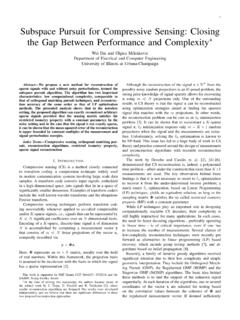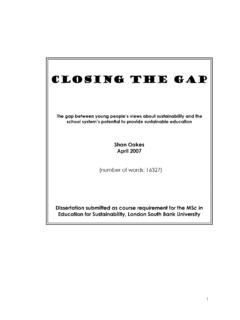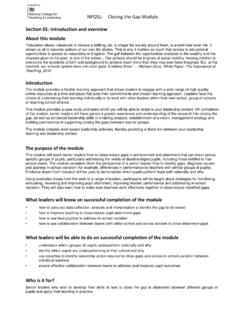Transcription of Closing the Gap Between ASIC and Custom: An ASIC …
1 Closing the Gap Between ASIC and custom : an asic perspective D. G. Chinnery and K. Keutzer Department of Electrical Engineering and Computer Sciences University of California at Berkeley ABSTRACT interconnect (specifically, aluminum interconnect for the technology considered). We investigate the differences in speed Between application- Among the fastest commercially produced processors is specific integrated circuits and custom integrated circuits when the Alpha 21264A, which runs at 750 MHz, with a supply each are implemented in the same process technology, with some voltage and 90W power consumption when in operation. It has an examples in micron CMOS. We first attempt to account for area of [1]. This processor uses dynamic logic and heavy the elements that make the performance different and then pipelining to achieve this speed[10][18]. examine ways in which tools and methodologies may close the performance gap Between application-specific integrated circuits IBM has designed a integer processor in and custom circuits.
2 Technology, with a supply voltage, and area, that Keywords consumes of power[21]. ASIC, clock frequency, clock speed, comparison, custom . ASIC microprocessors are not typical, because they bear more architectural similarity to custom microprocessors, but they 1. INTRODUCTION present a good mid-point Between custom design and a typical Speed of average application-specific integrated circuits (ASICs) ASIC design. Tensilica has a high performance 250 MHz lags that of the fastest custom circuits in the same processing ASIC processor[2], with an area of about 4mm2 (depending on geometry by factors of six to eight. There doesn't seem to be any the configuration). Finally, simply based on anecdotal clear consensus on the source of this performance difference, and information we postulate that average ASICs run at occasionally one encounters an implicit prejudice that poor Between 120 MHz and 150 MHz, and high speed network ASICs design skills in ASIC designers compounded by poor computer- may run at up to 200 MHz in technology.
3 Of course, one aided design (CAD) tools are at fault. In this paper we aim first may find ASICs that operate at slower speeds, but in these to develop a comprehensive rationale for the differences Between devices we presume that performance was specifically not a the speed of custom integrated circuits (ICs) and ASICs. We then criterion. Thus, at the outset, we can see that custom ICs operate aim to constructively explore the ways in which tools and 6 to 8 faster than ASICs in the same process. At first glance methodologies can close this gap. this gap seems staggering. If we put the speed improvement due to one process generation ( to ) as then We begin by giving examples of performance of both custom ICs this gap is equivalent to that of five process generations or nearly and ASICs. We then give a top-level overview of what we feel a decade of process improvement. In the following section we try accounts for the difference Between custom ICs and ASICs.
4 We to more precisely describe the factors that result in this then go through each of the factors that contribute to the significant speed differential. difference in detail. 2. ASIC AND custom COMPARISON 3. FACTORS CONTRIBUTING TO THE. To quantify the differences Between ASIC and custom chip DIFFERENCES. speeds, we first examine speeds of high performance designs and The following gives our overview of the maximum contribution typical ASIC designs in technology. When we refer to a of various factors to the speed differential Between ASICs and technology, we are referring to fabrication processes with similar custom ICs. design rules and transistor channel lengths, and with the same through architecture and logic design: heavy pipelining/few logic levels Between registers by good floorplanning and placement with clever sizing of transistors and wires for speed and good circuit design from use of dynamic logic on critical paths, Permission to make digital/hardcopy of all or part of this work for personal or instead of static CMOS logic classroom use is granted without fee provided that copies are not made or distributed for profit or commercial advantage, the copyright notice, the title of the due to process variation and accessibility publication and its date appear, and notice is given that copying is by permission of ACM, Inc.
5 To copy otherwise, to republish, to post on servers or to redistribute to lists, requires prior specific permission and/or a fee. DAC 2000, Los Angeles, California (c) 2000 ACM 1 -58113-188-7/00 $ When designing a custom processor, the designer has a full range overheads as about 20% for a custom design, the IBM PowerPC. of choices in design style. These include architecture and micro- processor with four pipeline stages is about times faster with architecture, logic design, floorplanning and physical placement, pipelining. and choice of logic family. Additionally, circuits can be optimized by hand and transistors individually sized for speed, What's the problem? lower power, and lower area. Thus if the speed improvements For pipelining to be of value, multiple tasks must be able to be associated with each element above are approximately correct initiated in parallel, and branches in execution will diminish then custom circuits could run 18 faster than their average performance.
6 Many designs, such as bus interfaces, have a tight ASIC counterparts. In practice, even the best custom designs interaction with their environment in which each execution cycle don't take full advantage of all these potential advantages over an depends on new primary inputs and branches are common. In ASIC. such cases, it is not clear how an ASIC may be reorganized to allow pipelining. Simply increasing the clock speed by adding Before reviewing each of the factors that contribute to speed latches would only increase latency due to the additional latch differentials it will be useful to review how the speed of an setup and hold times. integrated circuit is determined. The speed of a circuit is determined by the delay of its longest critical path, and the ASIC tools have problems with complicated multi-phase clocking length of the critical path is a function of gate delays, wiring schemes that would allow time borrowing Between pipeline delays, set-up and hold-times, clock-to-Q (the delay from when a stages to increase speed.)
7 While there are level-sensitive latches clock signal arrives at a latch to when the latch output stabilizes), in some ASIC libraries, typically only one or two clock phases and clock skew[26]. To improve the speed of an integrated are used. circuit requires reducing the delay of one or more of these Pipelining ASICs is also limited by the speed of registers in the elements. How these elements of the critical-path delay of a pipeline, and greater clock skew than carefully designed custom circuit are reduced by factors such as micro-architecture and ICs. There is typically 10% clock skew or more for ASICs, pipelining will be detailed in each of the following sections. compared with about 5% clock skew for a high quality custom design of clocking trees. The 600 MHz Alpha 21264 has 75ps 4. MICRO-ARCHITECTURE AND global clock skew, or about 5%[12]. Comparing the absolute HARDWARE IMPLEMENTATION: differences in clock skews, there is about a 10% increase in PIPELINING AND LOGIC LEVELS, speed due to custom quality clock skew alone.
8 AND LOGIC DESIGN Registers and latches in ASICs have additional overheads as they Pipelines place additional latches or registers in long chains of have to be more tolerant to clock skew, and require a far larger logic, reducing the length of the critical path, and allowing time absolute segment of the clock cycle, whereas custom designs can stealing Between pipeline stages with multi-phase clocking. include some logic within the latch to reduce the overhead. At high speeds in custom designs, latches still take a significant The IBM PowerPC chip has a single-issue pipeline with component of the cycle time, 15% in the Alpha 21264. four stages[22]. The Alpha 21264A processor has seven pipeline processor[12]. stages, but it has out-of-order and speculative execution. Similarly, the Tensilica ASIC processor has a single-issue five custom designs may also show superior logic-level design of stage pipeline[9], whereas typical ASIC designs may have no regular structures such as adders, multipliers, and other datapath pipelining and significantly longer critical paths.
9 Elements. They achieve fewer levels of logic on the critical path with more compact, complex logic cells and by combining logic A metric for expressing the number of logic levels in a design is with the latches. In a custom processor, careful design can in terms of the number of fanout-of-four (FO4) inverter delays balance the logic in pipeline stages after placement, ensuring that (an inverter driving four times its input capacitance)[15]. There the delays in each stage are close, whereas an ASIC may have are 15 FO4 delays in the Alpha 21264[12][15], and 13 FO4 unbalanced pipeline stages resulting in more levels of logic on delays in the GHz IBM PowerPC1. An ASIC typically has the critical path. significantly more levels of logic on the critical path; Tensilica's Xtensa processor is estimated to have about 44 FO4 delays2. Additional processing speed can be achieved by issuing multiple instructions, but this requires speculative execution with Estimating the pipelining overheads, such as clock skew and additional complex hardware logic (such as forwarding and latch overheads, as about 30% for an ASIC design, the Tensilica branch prediction) and more pipeline stages, unless there is a pipelined ASIC processor with five stages is about times high degree of parallelism in instructions.
10 There is a trade-off faster due to pipelining. Estimating the clock skew and latch Between issuing more instructions simultaneously and the penalties for branch misprediction and data hazards, which 1 reduce the performance, and additional hardware and design Calculated from the effective transistor channel length of cost[16]. The Alpha 21264 can issue up to six instructions per [21], using the rule of thumb that FO4 delay is in cycle, and has four integer execution units and two floating-point nanoseconds, the FO4 delay is 75ps. This gives 13 FO4 delays execution units[18], giving it significantly faster performance in a clock cycle. (Calculation courtesy of Andrew Chang.). when instruction parallelism can be exploited. 2. Assuming effective transistor channel length in a typical ASIC process. (Calculation courtesy of Andrew Chang and Ricardo Gonzalez.). What can we do about it? by reducing the resistance. Additional buffers may be included to If processing the data is interdependent, there is little that can be drive large capacitive loads that would be charged and done to pipeline ASIC designs.









